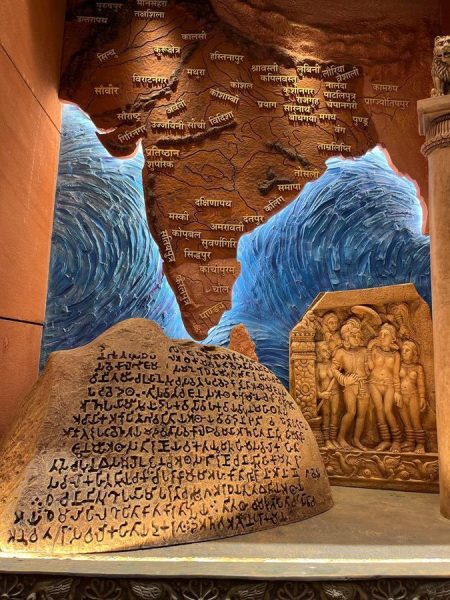
India’s neighbours bristle at Akhand Bharat mural; how legitimate is the map's claim?
Pakistan and Nepal object to inclusion of geographical locations in their territories; was unified India even an entity pre-British?

At a time when the Narendra Modi government is smarting from the humiliation of an Opposition boycott of the new Parliament inauguration, a mural representing BJP’s pet concept of ‘Akhand Bharat’ or the map of ancient India at the building, has riled up India’s neighbours, especially Pakistan and Nepal, who have protested the inclusion of geographical locations in their territories in the said map.
What is the controversy about?
The mural, installed on a wall of the new Parliament building, depicts ancient Indian kingdoms and shows India’s expanse till Takshashila (now a part of current-day Pakistan) and Lumbini and Kapilavastu (now in Nepal).
Known to be a renowned site of Buddhist Gandhara, Takshashila or Taxila situated in Pakistan’s Punjab Province, is currently a UNESCO World Heritage Site. While Lumbini, the birthplace of Gautam Buddha is a sacred religious site for Buddhists, the ancient city of Kapilavastu, known as the republic of the Shakya dynasty, is where Lord Buddha is believed to have lived as Prince Siddhartha till he left the palace for an ascetic life.
Also read: Once a whisper, RSS slogan of ‘Akhand Bharat’ now a dangerous chorus
Even though makers of the mural define it as a depiction of “influence of Indian thought during the ancient ages,” chest-thumping rhetoric by a few BJP leaders like Prahlad Joshi and Manoj Kotak that the map represents the party’s resolve for Akhand Bharat, has upset Pakistan and Nepal, with political outfits in both countries demanding its removal.
“The resolve is clear – Akand Bharat,” Joshi, the Union Minister of Parliamentary Affairs, tweeted.
“Akhand Bharat in New Parliament. It represents our powerful & self-reliant India,” Manoj Kotak, Lok Sabha member from Mumbai North-East, said in his tweet.
Snaps of the mural were also shared by the Karnataka unit of the BJP with tweets supplementing claims that it stood as a “symbol of the vitality of our proud great civilization.”
Revisionist, expansionist mindset, snaps Pakistan
Peeved over the inclusion of geographical locations which are part of current-day Pakistan in the mural, the country’s Foreign Office spokesperson Mumtaz Zahra Baloch said it portrayed the “revisionist” and “expansionist mindset” of the Indian government.
“We are appalled by the statements made by some BJP politicians, including a union minister, linking the mural with ‘Akhand Bharat’,” Baloch said.
She asserted that the concept of Akhand Bharat doesn’t only seek to subjugate the identity and culture of India’s neighbours but also its own religious minorities. In a word of advice for the Modi government, she said, India, instead of nurturing such “hegemonic” ambitions should rather focus on resolving disputes with its neighbours to bring peace in South Asia.
“It is a matter of grave concern that the idea of Akhand Bharat is being increasingly peddled by individuals belonging to the ruling dispensation in India. The Indian politicians are well advised not to indulge in rhetoric against other countries merely to further their divisive and parochial agenda,” she said.
Demands to pull down mural
The issue also raked up a political storm in Nepal, with Opposition parties putting pressure on Prime Minister Pushpa Kamal Dahal, also known as ‘Prachanda’ to raise it with Indian officials and get the mural removed, during his visit to India.
Also read: At MVA rally, Uddhav dares Modi, BJP to fulfil Savarkar’s dream of Akhand Bharat
“If a country like India that sees itself as an ancient and strong country and as a model of democracy puts Nepali territories in its map and hangs the map in Parliament, it cannot be called fair,” former Nepalese prime minister KP Sharma Oli said.
“The prime minister is going to India tomorrow. He should ask them to remove the mural. (Dahal has) to talk to the Indian government to correct that mistake. There is no point in visiting India if you can’t do that,” Oli said on May 30, a day before Prachanda’s visit to India.
Several lawmakers of Prachanda’s own party have also taken exception to the mural and the prime minister is said to have pacified them with the promise of discussing the issue with the Modi government.
Is Akhand Bharat a legitimate claim?
Akhand Bharat refers to the concept of an undivided India whose geographical expanse in the ancient past is said to have reached up to Afghanistan, Pakistan, Bangladesh, Sri Lanka, Myanmar and Thailand.
Initially pitched by Hindu Mahasabha leader and RSS ideologue Vinayak Damodar Savarkar at the Mahasabha’s 19th Annual Session in 1937, the concept has come to be a mainstay of the Hindutva ideology and the concept of ‘Hindu Rashtra’ that the RSS and BJP propound.
Also read: ‘Akhand Bharat’ row: 6-yr-old tweet by U’Khand’s new CM ruffles feathers
The RSS, of late, however has maintained that the Akhand Bharat concept, in the present times, should be seen in the cultural context and not politically given the partition of India on religious lines at the time of Independence.
Historians have differed with the idea with a majority of them contending that the term ‘Akhand Bharat’ is essentially a misnomer as India was never a unified entity before the arrival of the British. History of the region before the arrival of the British shows that rather than being a unified political territory, it was a conglomeration of warring princely states.

